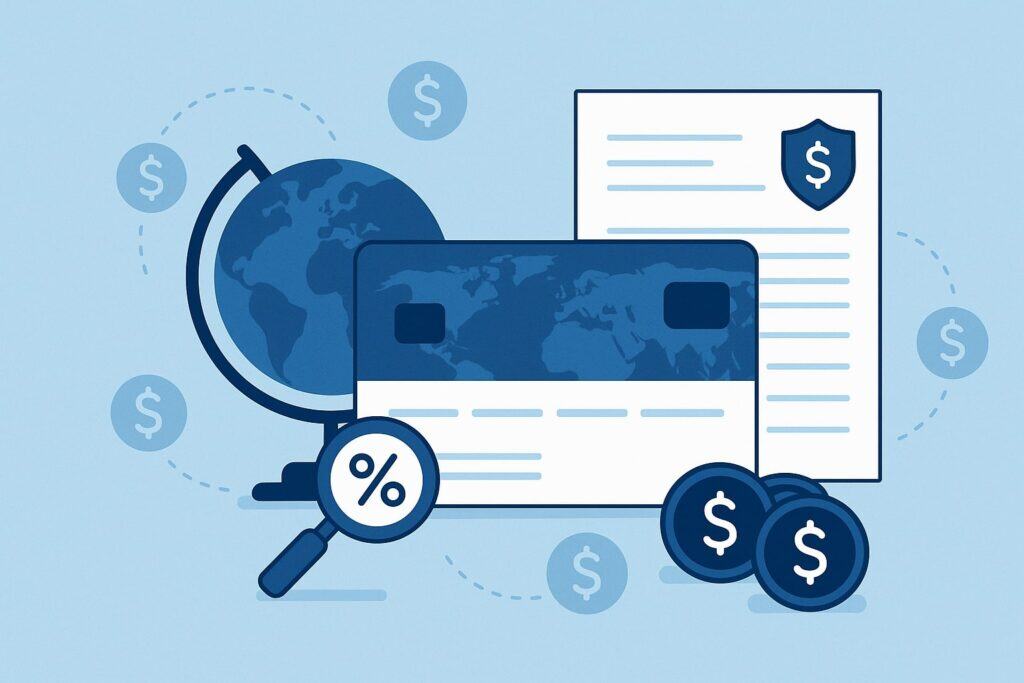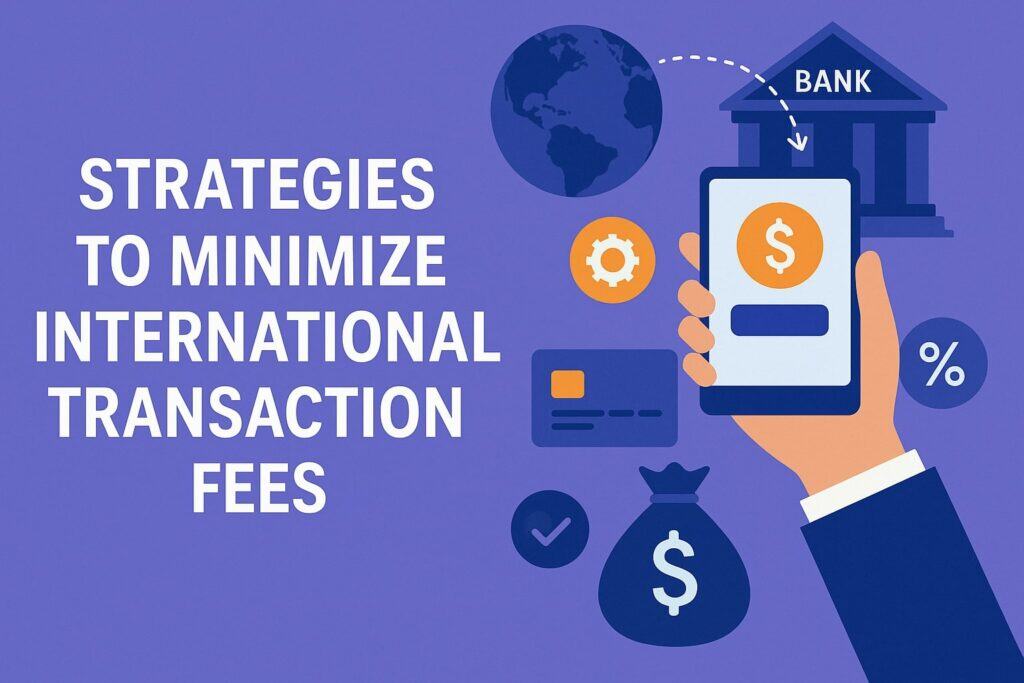
By crossborderfees September 27, 2025
International transaction fees, sometimes called foreign or cross-border fees, are extra charges banks, card networks, or payment providers impose when a payment crosses borders or requires currency conversion. These fees usually include a percentage of the transaction (commonly 1%–3%) and sometimes a fixed per-transaction charge.
For example, many U.S. banks levy roughly 1–3% of the amount plus $15–$50 per international transfer. Online processors add fees too: Stripe, for instance, tacks on +1.5% for any non-U.S. card and +1% for currency conversion.
Even seemingly small percentages can add up. One e-commerce example showed a $100 sale yielding only $95.11 after a $4.89 processing fee. In other words, 4.89% of the revenue vanished. Over many transactions, such costs “eat into profit margins”.
This effect is universal – whether you’re an online retailer selling abroad, a freelancer collecting overseas payments, a multinational paying international suppliers, or even a traveler spending on foreign credit cards.
In each case, those extra fees directly reduce the net dollars or cents you keep. In this article, we explain how these fees are calculated, show how they erode profits in practice, and share practical strategies to minimize or avoid them.
What Are International Transaction Fees?

International transaction fees are any surcharges applied to payments involving another country’s currency or banking system. In practice, they arise at multiple points in the payment chain.
For example, credit card networks (Visa, Mastercard, etc.) usually charge ~1% to convert your purchase into your home currency, and the issuing bank may add another 1–2% on top. Banks typically add currency-conversion markups (often 1–4%) plus flat wire-transfer fees.
In fact, Airwallex notes that these foreign transaction charges are “usually between 1% and 3% of the transfer amount”. Capital One likewise explains that most issuers impose a 1–3% fee on each foreign purchase.
Other examples include:
- Bank and Wire Fees: U.S. banks often charge a flat fee (say $15–$50) plus around 1–3% of the amount on international wires.
- Payment Processor Fees: Payment gateways typically layer extra percentages on top of their base rates for international sales.
For instance, Stripe’s standard plan adds 1.5% for non-U.S. cards and 1.0% for currency conversion. PayPal likewise adds a 1.50% surcharge on cross-border business transactions (above its normal 2.9%+30¢ rate). - Dynamic Currency Conversion (DCC) Fees: When merchants offer to charge you in your home currency, they apply DCC.
This often involves a large hidden markup. As Shopify warns, paying via DCC might seem to avoid foreign fees, but in reality “a third party undertaking the conversion” and a poor exchange rate usually adds extra cost.
In short, every step of a cross-border payment – card network, issuing bank, processing gateway, currency conversion – can contribute fees.
Individually they might be 1–3%, but combined they significantly reduce the amount received. These added costs are part of the cost of doing business internationally, effectively shrinking your effective revenue on each transaction.
Impact on Profit Margins

E-commerce and Retail Businesses
For online retailers selling globally, international fees directly eat into each sale’s gross profit. For example, Shopify shows that on a $100 international order with a 4.4% + $0.49 fee structure, only $95.11 is delivered after processing.
If your product’s normal profit margin was 30% ($30 on a $100 sale), that drops to about 15.1% ($15.11) after the fee – a 50% reduction in profit. Over thousands of orders, the cumulative loss can be huge.
As one fintech blog notes, doing a few dozen such payments per month can amount to tens of thousands of dollars per year in fees. Even a 2% foreign fee on $1 million in annual exports is $20,000 less profit.
In practice, many e-commerce businesses either adjust prices or accept slightly lower margins on international sales to account for these costs. Without adjustment, growing your volume abroad could paradoxically yield less profit growth due to the extra fees.
Freelancers and Small Businesses
Independent contractors and small exporters face a similar squeeze. A freelancer billing $1,000 to a foreign client could see $40–$50 vanish to fees if using PayPal or a credit card processor (since PayPal’s overseas rate is ~4.4%+fixed).
Over multiple clients or projects, that’s effectively unpaid work. Payoneer warns that without a savvy payment strategy, businesses end up paying hidden costs like mid-market markups and extra transfer fees. In other words, what you invoice isn’t what you receive on the net.
Many freelancers counter this by using low-cost platforms (like Wise or Payoneer) or asking clients to pay via ACH/invoice to avoid card fees. Otherwise, a 2–4% fee on each invoice directly cuts into their overall earnings and must be factored into pricing or taken as reduced margin.
Multinational Corporations
Even large companies feel the pinch, though they usually have more tools to fight back. Multinationals making large international payments (payroll, global suppliers, etc.) can negotiate better rates or use dedicated treasury services, but each cross-border transaction still incurs fees.
On multi-million-dollar transfers, a 1% fee can cost six figures. That’s why corporate treasury teams manage currency exposure carefully. For example, Airwallex notes that changes in exchange rates can impact costs and margins: if a home currency weakens, the cost of foreign expenses rises, squeezing profit until hedges or currency balances are used.
Industry experts emphasize that actively managing FX and payment costs leads to “healthier profit margins”. Large firms often hold local-currency bank accounts or use hedging instruments to minimize the net effect, but the transaction fees themselves remain a line item in their cost structure.
In summary, for multinationals each percentage point of fee saved on hundreds of millions of cross-border payments translates to significant profit protection.
Consumers and Travelers
While not a “business profit” issue, individual consumers also face similar fees that reduce spending power. Credit cards commonly charge a 1–3% foreign transaction fee on overseas purchases, which effectively adds a hidden cost to travel or international online shopping.
As Wise observes, “international transaction fees can quickly add up, affecting both personal travel expenses and business costs”. In practice, a 3% fee on hotel or meals means you get 3% less value for each dollar you spend abroad.
Though this isn’t a profit margin per se, it’s the same concept: hidden cross-border fees reduce the real purchasing power of every foreign transaction. Many travelers therefore carry no-foreign-fee cards to avoid these costs, mirroring how businesses seek no-fee methods to protect profit.
Calculating the True Cost
To see the full picture, it helps to break down an example transaction. Shopify illustrates a typical multi-step process for a $100 overseas sale: first the customer’s bank converts $100 to euros at a base rate (say €90).
The bank then applies a 1–4% markup to that rate (e.g. the customer pays €91.80 instead). Next, the bank charges its foreign transaction fee (e.g. 3%), adding €2.75 for a total €94.55 charge. Finally, the online payment processor takes its fee on the $100 (for instance, Stripe’s 4.4%+49¢ = $4.89).
In this case the seller receives only $95.11. In summary, the buyer paid €94.55 (about $105.06 at the original rate) for a $100 item, and the seller netted $95.11. All the exchange-rate markups and percentage fees above the base sale price were fees.
In larger transactions, the percentage may be smaller but the dollar impact is bigger. Overall, these calculations show that every fee directly reduces the gross amount you keep. As one consultant warns, “transaction fees can quickly add up” and must be managed to avoid unknowingly shrinking your bottom line.
Strategies to Minimize International Transaction Fees

While you often can’t eliminate fees entirely, there are many practical steps to reduce their impact:
- Hold Funds in Multiple Currencies: Open multi-currency accounts (through services like Wise, Airwallex, or your bank) so you can receive and spend in local currencies. By only converting when needed, you avoid multiple FX markups. For example, keep euros and dollars separate so you don’t repeatedly convert back and forth (each conversion attracts a fee).
- Use Cards/Accounts with No Foreign Fee: Many travel or business credit cards waive international fees. Capital One notes that some cards “don’t charge foreign transaction or currency conversion fees”.
Issuing such no-FX-fee cards to employees means that any foreign purchase incurs only the merchant’s usual rate, not an extra 1–3%. Likewise, fee-free bank accounts (like Schwab’s for U.S. users) can eliminate ATM and overseas debit charges. This simple step can save 2–3% per card transaction. - Choose Low-Cost Transfer Services: Instead of traditional wire transfers, use fintech platforms. Services like Wise (TransferWise), Payoneer, Revolut, or OFX often offer much better exchange rates and lower flat fees than banks.
For instance, Wise uses the mid-market rate plus a small fixed fee, which can cut the cost of sending money by over half. Batch invoices or payments when possible: higher volumes may qualify for reduced fee tiers.
Many freelancers and SMEs use these platforms to pay overseas workers or suppliers to avoid hefty bank fees. - Optimize Payment Processors: Review the fee schedules of your gateways (Stripe, PayPal, etc.). Some providers offer custom or volume-based pricing. For example, Swipesum notes that high-volume businesses can often negotiate lower rates with Stripe (interchange-plus pricing).
Also, enable local payment methods: accepting ACH transfers (0.8% fee with Stripe) or SEPA in the EU can be much cheaper than cards. Audit your monthly statements to ensure you’re not paying unnecessary add-ons. - Decline Dynamic Currency Conversion: When charged by a foreign merchant, always choose to pay in the local currency.
Do not accept paying in your home currency via DCC, as it typically uses a worse exchange rate and sneaky fee. Paying in local currency and letting your bank convert at its rate usually ends up cheaper, even with your bank’s foreign fee. - Negotiate and Audit Fees: Regularly question your bank and processor fees. As costs grow, ask for better terms or volume discounts.
Some banks will cap wire fees or reduce percentage markups for large corporate clients. Work with a payments consultant if needed. Keep an eye out for hidden charges, and ensure any flat fees (e.g. SWIFT intermediate bank fees) are accounted for. - Pass or Account for Fees: If possible, incorporate these costs into your pricing. In some regions, merchants “dual price” – charging foreign customers an extra percentage to cover international fees (though check local regulations on surcharges).
At minimum, treat all foreign fees as legitimate business expenses, which can often be written off. For example, Shopify notes you may be able to deduct these charges as costs of doing business. Being aware of them prevents suddenly eroding profit.
By combining these strategies – using the right tools, negotiating proactively, and planning prices – you can substantially reduce the impact of cross-border fees. For many businesses, the savings from just a few percent improvement in FX costs translate into healthier profit margins over time.
Frequently Asked Questions
Q: What exactly is an international transaction fee?
A: It’s a surcharge on payments that go through a foreign currency conversion or overseas banking system. In simple terms, if you pay, invoice, or withdraw money in another country’s currency, your bank or card issuer may add an extra percentage (usually 1–3%) as a fee. This fee covers the cost of processing a cross-border payment.
Q: Who ends up paying these fees – the buyer or the seller?
A: Typically, the cardholder (buyer) sees the foreign transaction fee on their statement when they make a purchase abroad. However, merchants also effectively pay extra.
For example, when a foreign customer pays your e-commerce store, your payment processor may charge you a higher fee (a cross-border surcharge).
In practice, both sides are affected: banks often pass fees to the payer, but the seller’s bank or gateway takes more from the merchant fee pool. As Papaya’s analysis puts it, U.S. card issuers usually pass on the extra cost in the form of fees.
Q: How large are international transaction fees?
A: Commonly, the total extra cost is around 2%–5% of the transaction. For instance, credit cards often charge ~1% (network fee) plus 1–3% (issuer fee). Banks may add fixed wire fees ($10–$50) on top of a 1–3% currency markup.
Payment services like PayPal add about 1.50% on top of their usual rate for foreign transactions. So in aggregate, you can expect a few percent lost on each international payment, though the exact amount varies by provider.
Q: How do these fees impact my profit margins?
A: Every international fee directly reduces the net revenue from a sale. If your product’s margin was 10% of price, a 3% fee effectively consumes 30% of that profit. Over many sales, even a 1–3% fee difference can translate to large absolute losses.
As one expert notes, high cross-border fees “can quickly add up, eating into profit margins.” Businesses must account for this when setting prices or estimating profits, because ignoring the fees can make your income projections overly optimistic.
Q: What strategies can reduce or avoid these fees?
A: Some key tactics include: using multi-currency accounts to avoid unnecessary conversions; paying with credit cards or accounts that have no foreign transaction fees; sending/receiving payments via low-cost platforms (Wise, Revolut, Payoneer, etc.); and declining dynamic currency conversion at checkout.
Also, negotiate with your bank/payment provider for better rates as volume grows. Each of these steps can trim off parts of the fee structure.
Q: Are there payment methods without international transaction fees?
A: Yes – travel-focused credit cards (like many issuers’ premium cards) often charge no foreign transaction fee, meaning you pay only the standard merchant charge. Some fintech products (Wise multi-currency accounts, Payoneer, Skrill, etc.) also advertise minimal fees.
Likewise, ACH transfers or local payment rails (e.g. SEPA in Europe) have much lower costs than SWIFT wires or cards. Choosing these options can eliminate the typical 2–3% penalty on international payments.
Q: What is dynamic currency conversion (DCC)?
A: DCC is when a foreign merchant or ATM asks if you want to pay in your home currency instead of the local currency. It sounds convenient, but typically the exchange rate offered is worse than your bank’s rate, and the difference becomes an extra fee.
In practice, you usually lose money with DCC. For this reason, experts advise always to pay in the local currency and let your own bank handle the conversion – you’ll get closer to the true market rate.
Conclusion
International transaction fees are a hidden cost of global commerce. While each individual fee may seem modest (just a few percent or a small fixed charge), they compound across sales and transfers to significantly erode profit margins. U.S. businesses – from online shops and freelancers to large multinationals – all feel this impact when money crosses borders.
The good news is that these costs are measurable and controllable. By understanding the fee structure and actively managing payments (through multi-currency tools, no-fee cards, savvy invoicing, and negotiation), companies can protect their bottom line.
In fact, financial experts emphasize that controlling foreign exchange and transfer costs leads directly to “healthier profit margins”. In the end, staying on top of international payment fees isn’t just about saving dollars today – it’s about ensuring predictable, sustainable profits as your business operates globally.